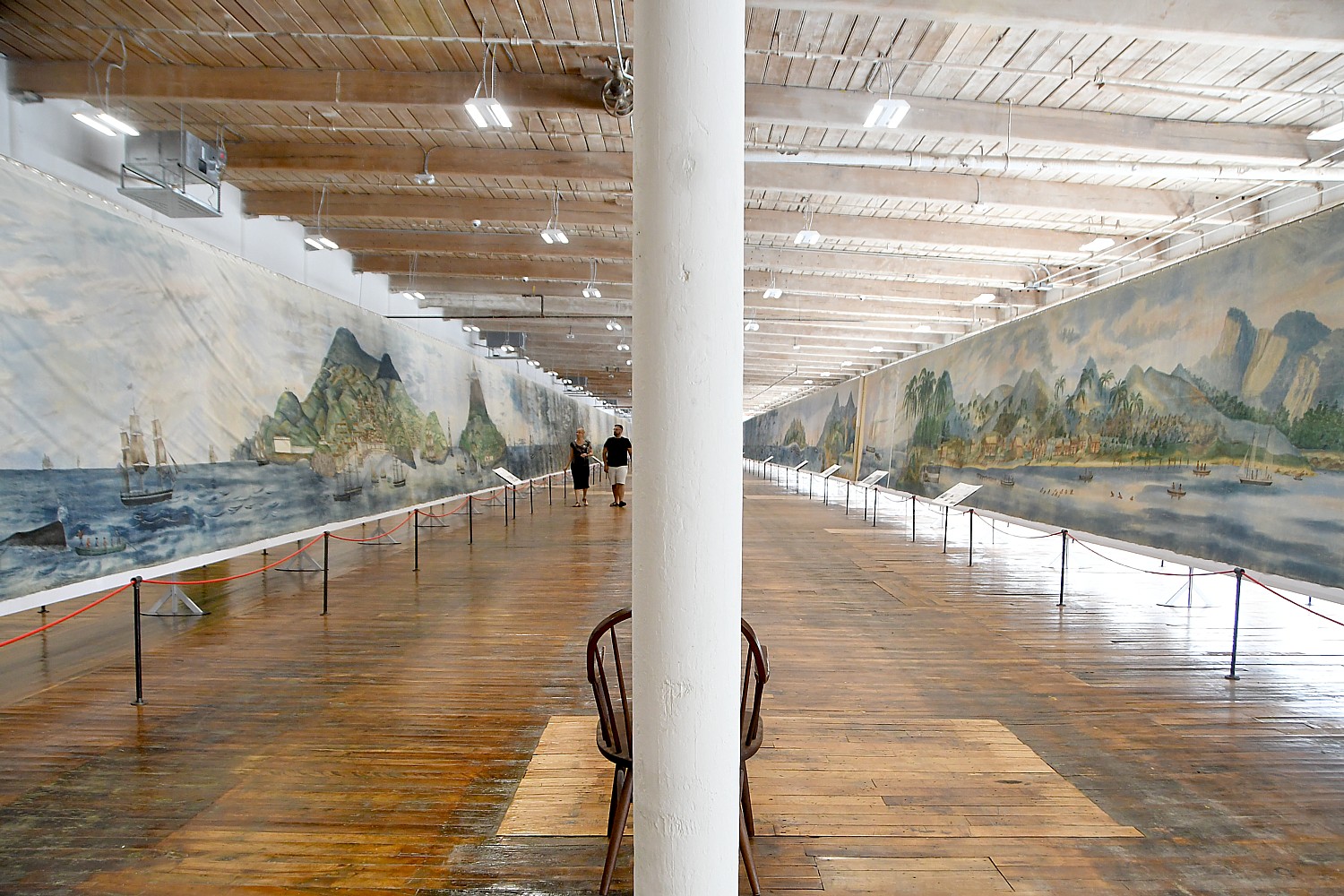
By Karen Rubin, Travel Features Syndicate, goingplacesfarandnear.com
The New Bedford Whaling Museum calls its special exhibition a “A Spectacle in Motion” – a title that proves to be anything but hyperbole. Imagine before documentary, before moving pictures, before photography, where the only way people could see images of places beyond their own experience was through painting, etched drawings in newspapers, or scrimshaw. Now imagine a whaling voyage that starts in New Bedford and travels thousands of miles to Fiji, painted on one mural, nearly one-quarter mile long – the longest painting in America. I can only imagine the sensation “The Grand Panorama of a Whaling Voyage ‘Round the World,” caused when it was first exhibited in 1849.
“Purrington & Russell’s Original Panorama: Whaling Voyage Round the World. Three Miles of Canvas” a poster from the Boston showing in 1849 proclaims. “Tickets 25 cents, half-price for children” (at a time when the sailors themselves earned $1 a day).
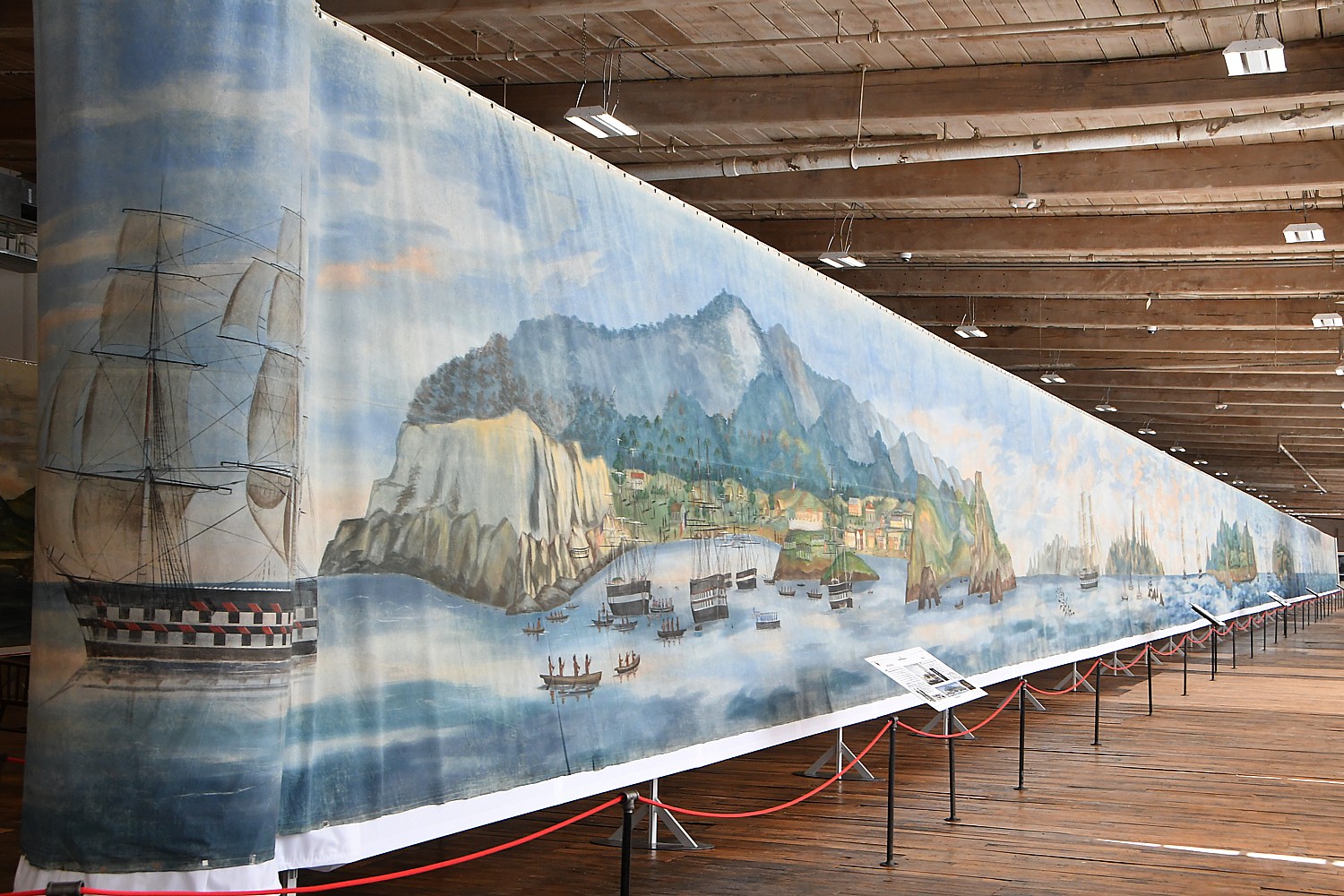
The mural, which is only rarely displayed in its entirety, has not been seen since the 1960s and is only on public view through October 8 by the New Bedford Whaling Museum, in New Bedford, Massachusetts (and very possibly never again), is a documentary of the whaling voyage, and while it stays still, it is you that gives it motion as you walk down the long, long stretch of each of the four panels – altogether nearly one-quarter mile long. But in its day, it was designed to be rolled so that it did in fact create a moving picture.
Coming upon this spectacle was one of the highlights of the Blount Small Ship Adventure cruise of New England Islands, all the more thrilling because it was completely unexpected, as most highlights and adventures are. As I was leaving the New Bedford Whaling Museum, I spotted a flyer saying that there was a free shuttle to “the mural.” I took a leap of faith and within moments, was traveling in the van for the five-minute, two-mile drive to the historic Kilburn Mills,as the van driver (a 47-year veteran of the museum who had a hand in moving it and laying it out to be photographed for the digitized exhibit) explained. Even after he gave me some sense of what the mural was about and why it needed to be housed in such a sprawling building, I was completely unprepared for what I would encounter. Indeed, seeing the Grand Panorama proved to be a thrilling experience and not a mere ‘viewing”. But as I climbed the flights of stairs to the fourth floor and got my first glimpse, it was, OMG. It took my breath away. Titling the exhibit “A Spectacle in Motion” was not over-selling.

The mural, in four panels each that stretches the entire length of the mill, is as long as the Empire State Building is tall; it is the longest painting in America.
Painted in 1848 by two New Bedford artists, Caleb Purrington and Benjamin Russell based on Russell’s actual around-the-world whaling journey, the mural documents every aspect of the places visited as well as key events. You see Pitcairn, settled by the Mutineers of the Bounty wound up; the scene as the whale rammed the Essex, the 1820 event that inspired Herman Melville’s “Moby Dick”; the island of Juan Fernandez off Chile, the temporary home of castaway Alexander Selkirk who was the model for Defoe’s “Robinson Crusoe.” It shows in gory detail the harpooning of a whale, blood spewing into the water; the danger as whalers are thrown into the churning sea; the 1847 eruption of the volcano at Fogo, Cape Verde, spewing its orange-red lava; sailing through a dark furious storm.
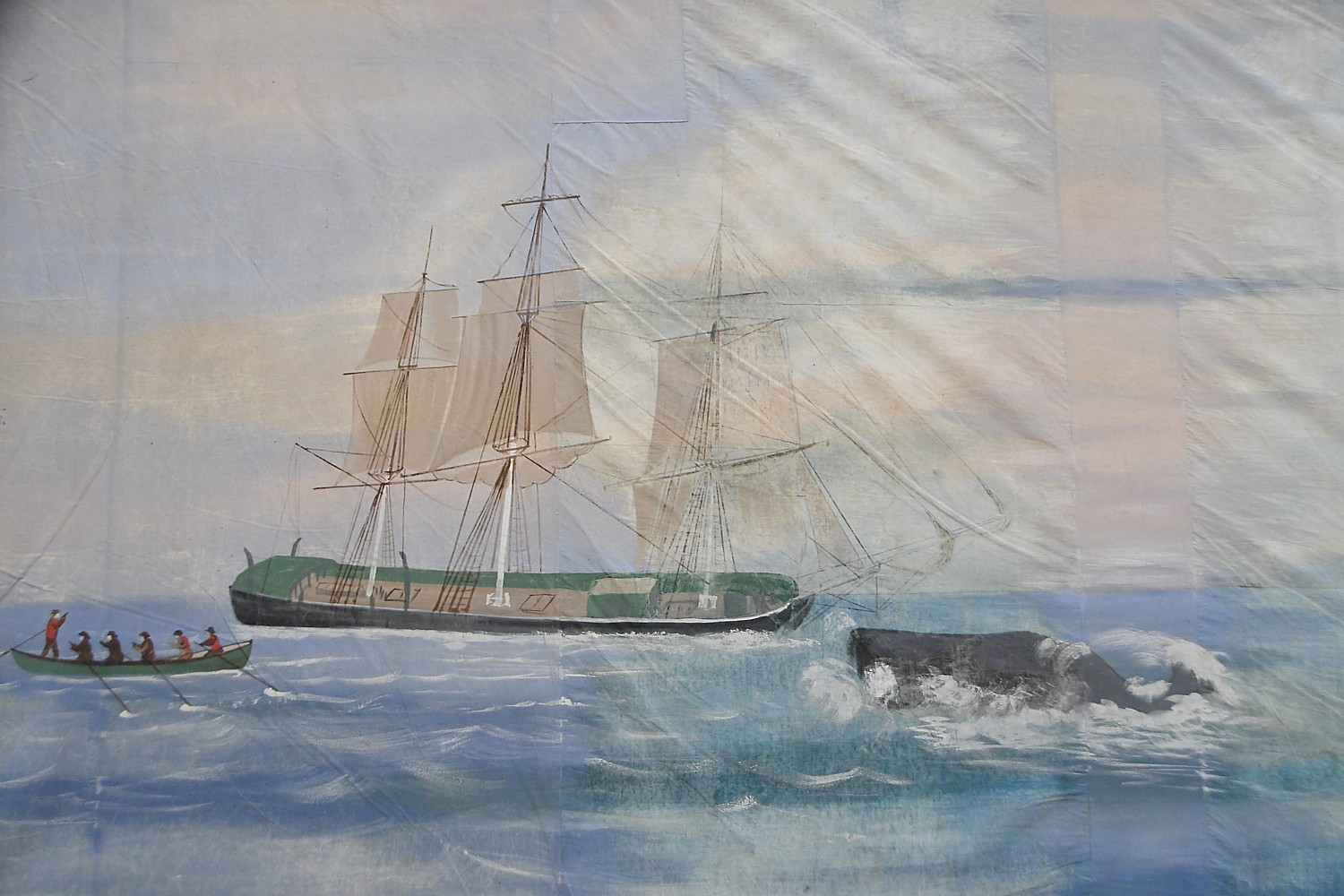
The voyage starts in New Bedford, with the first section looking so much as it does from the water as we have seen, coming into port on Blount Small Ship Adventures’ Grande Caribe.
The last scene is in Fiji and the last panel is curious: it seems to depict two women, one giving birth and the other a midwife.
I can only imagine the sensation that The Grand Panorama of a Whaling Voyage ‘Round the World caused when it was first exhibited in 1849 – before documentary, before moving pictures, before photography, when the only way to get a visual impression of some place beyond your own experience was through painted or drawn images. But this goes so far beyond. Over the course of 1,275 feet, the mural documents the entire whaling voyage, from its departure from New Bedford, to Fiji Islands. Along the way, it shows the blood, gore, the dangers and hardships of whaling. And because you move, it is the closest thing to a “moving” picture documentary they would have had.
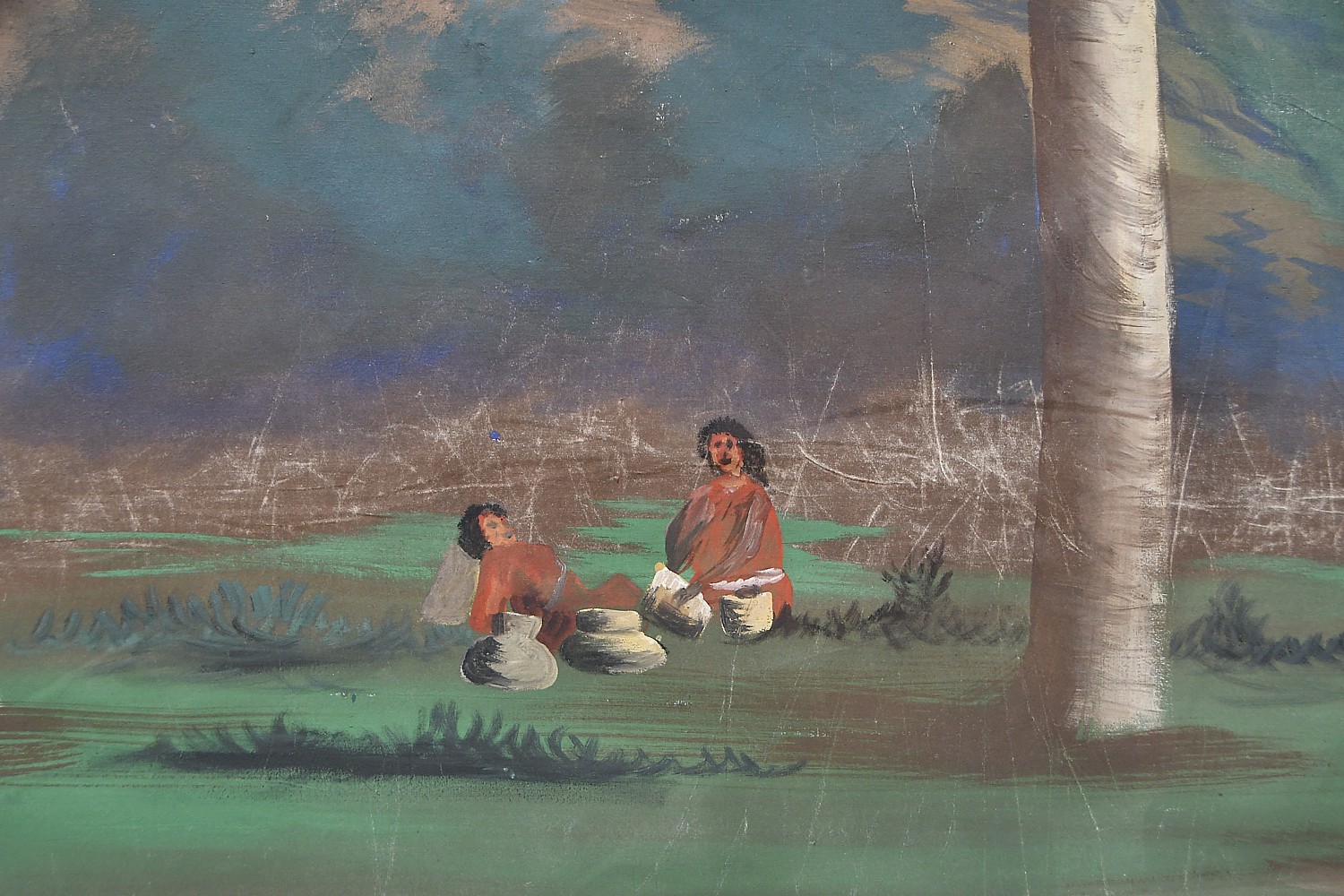
But where the mural transported these 19th century viewers to places on the globe they had never been – it was the 3D Imax, the Virtual Reality of its day- it transports us back in time. And in its day, it was designed to actually move. Before moving pictures, the scrolls were cranked on either side like reels of film, and displayed on a theater stage.
The New Bedford Whaling Museum calls the exhibit “Spectacle: A Voyage in Motion” in appropriate typeface that shouts its excitement. It is astonishing, captivating, awesome – on so many levels – the sheer size and ambition, the quality of the art – the delicacy and fine line of scrimshaw, stunning use of colors – the insights into the events – the importance of the subject, and on top of that, the achievement of restoring the painting – and finally, the enormity and rarity of the work being displayed at all – just the process of unrolling it and hanging it for display damages the painting.
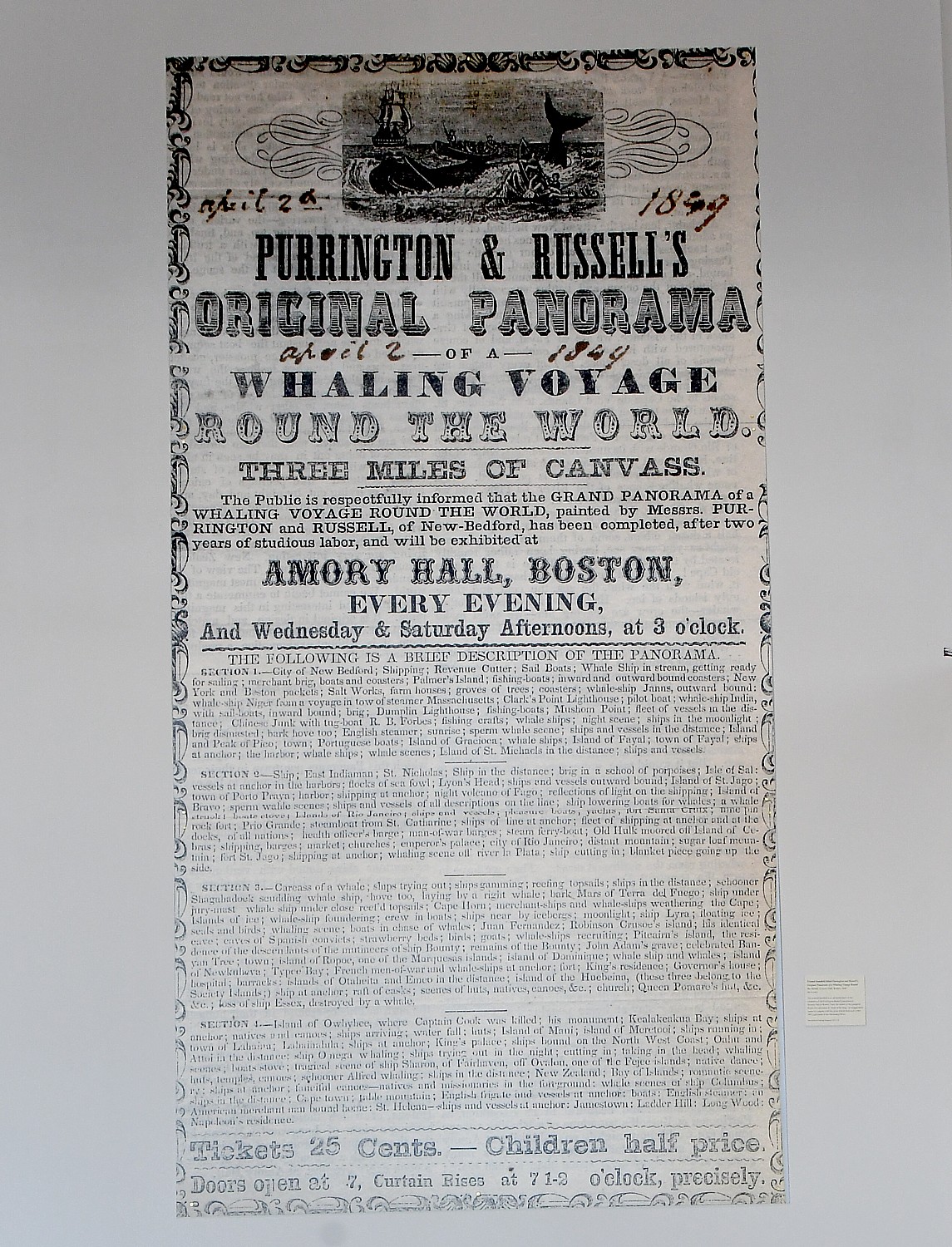
The museum spent two years restoring the mural, which originally was shown by rolling it so that the images actually did move – and important details of that conservation process, along with historical notes, are provided that are fascinating.
The mural is displayed in four sections that each cover the entire length of an historic textile mill (textile manufacturing displaced whaling when that industry collapsed, and then was replaced itself in the 1950s when climate controls made it possible to manufacture more cheaply in the South, which was then replaced by tourism).
Given the extraordinary length, the fragility of the painting, the sheer cost of moving it, setting it up, and finding a room big enough to display it, this is the first time in generations that the entire Panorama can be seen by the public.
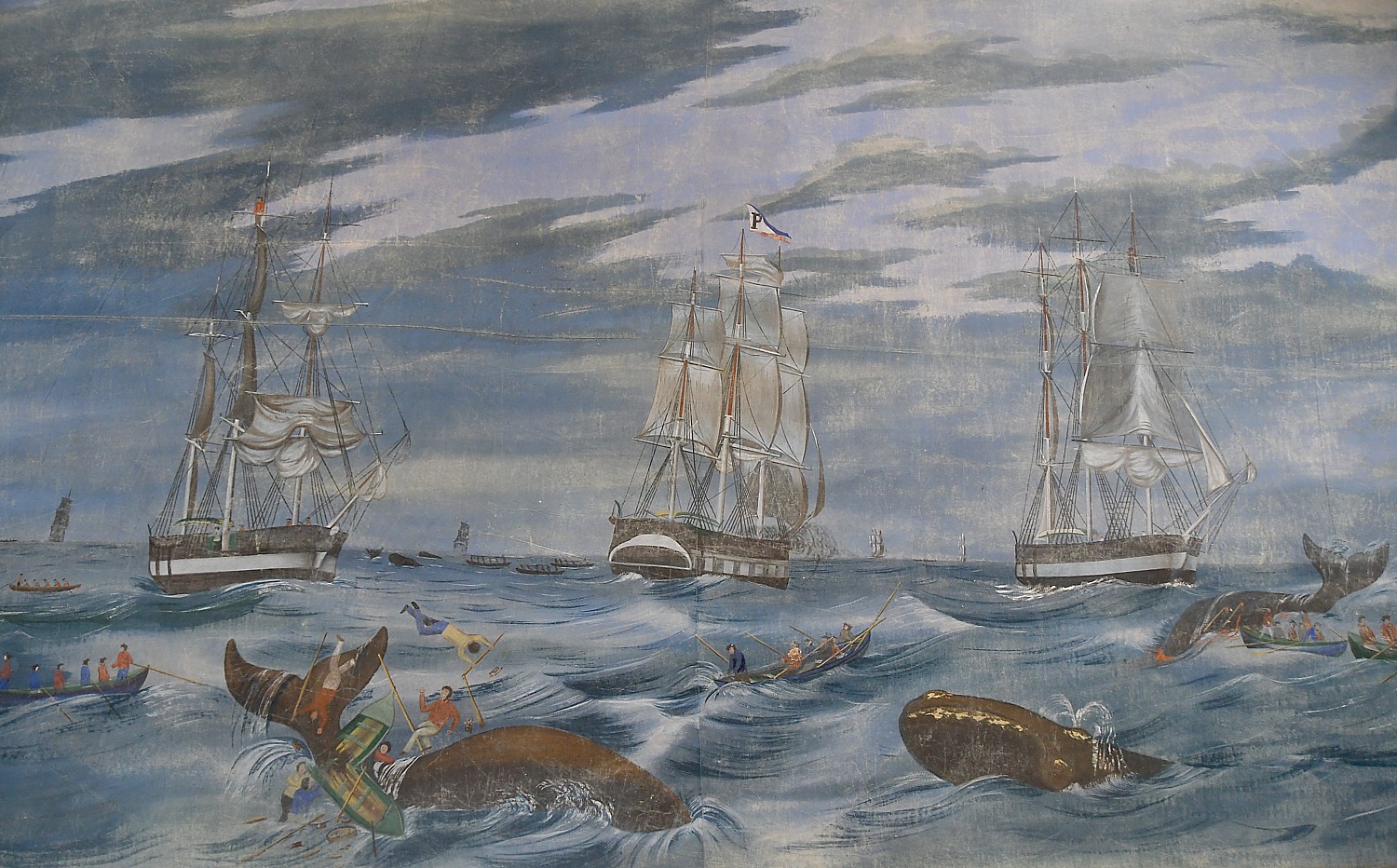
From where it is unfurled in the building two miles from the Whaling Museum, you travel around the world and back in time with the whalers without ever leaving the city. The exhibition’s interpretive panels and kiosks are fascinating to enrich the context and content of the Panorama, as well as to give a fuller appreciation of what went into the two-year restoration project.
The notes from the museum describe the Panorama as “a maritime artwork of national historical importance, authentically depicting a whaling voyage originating from the port of New Bedford in the mid-19th century. It was painted in 1848, by New Bedford artists Caleb Purrington and Benjamin Russell, who traveled it around the country as a commercial enterprise.”
The panorama as a form of public entertainment was developed in Europe in the late 18th century and subsequently made its way to the United States after demonstrating its commercial potential to an armchair traveler audience. Robert Barker, who patented this exhibition style, defined a “panorama” as “all view.”
He felt that spectators should feel like they were “really on the very spot,” that they should feel as if they were part of the scene in a surrogate reality, an imaginary “Grand Tour” of the world.
This is precisely what visitors will experience. It was the Virtual Reality of its day.
In the late 1840’s and early 1850’s, well before the age of cinema, the Panorama was designed and performed as a moving panorama, a form of entertainment where multiple scrolls moved across a stage similar to how a reel-to-reel film would later be shown.
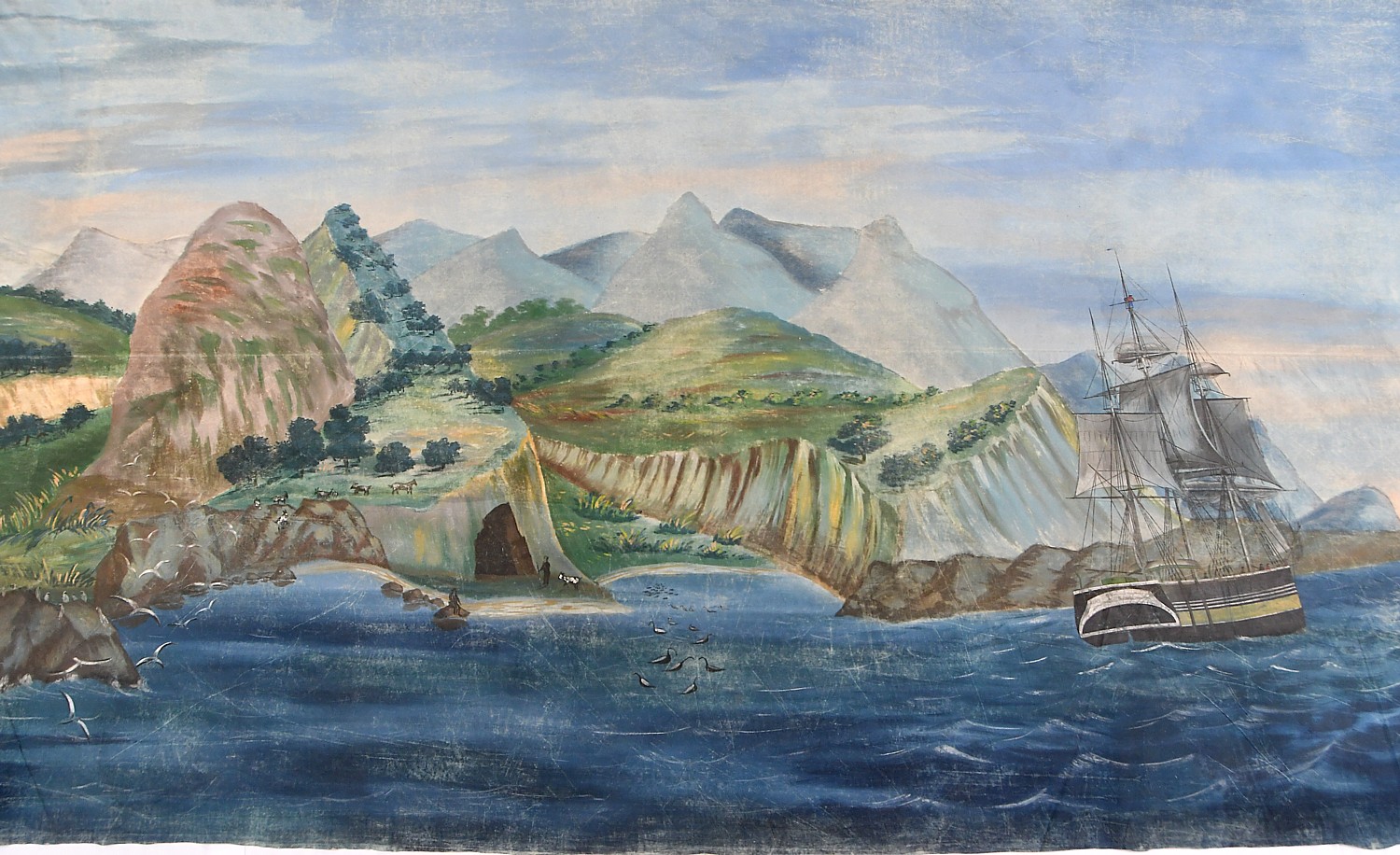
But, “after years on display, the wear and tear on the 170-year old painting was so extensive that it was deemed worthless and impossible to conserve. After decades of conservation planning and method strategy research, the Museum brought this national treasure back to life and is proud to share it with the public. However, due to the extensive conservation efforts that have been invested into the painting, it will no longer be shown in its original format – as a moving panorama – as this would undo the extensive work recently completed.”
The Panorama drew crowds in the era of public entertainment before moving pictures and films. To celebrate this origin, the exhibition is coupled with dynamic and engaging programming all summer long. Live performances, contemporary artistic presentations, and other unique interpretations accompany educational programs and cultural celebrations.
Plan on being dazzled for at least one to two hours.
The exhibit is billed as a “once-in-a-lifetime experience” and is free and open to the public, through Columbus Day, October 8, 9 am to 5 pm at Kilburn Mill (the museum provides a free shuttle service every half hour from 10 am to 5 pm through Labor Day).
The Grand Panorama: The Experience
As the Panorama was being conserved, it was photographed at high resolution to produce this fully digitized recreation of the entire painting for the first time, allowing the Museum to create a exhibition of The Grand Panorama it calls “The Experience” – recreating the same experience the 19th century audiences had of seeing the original Panorama on a theatrical stage, with music and narration.
You stand on the bow of the world’s largest model whaleship, the Lagoda, and watch the Panorama scroll by in a life-sized digital format projected in a full theatrical setting, and experience what Benjamin Russell and other whalers saw as they left the port of New Bedford and traveled the sea in search of whales. This re-creates the experience that the 19th century viewers would have had, since the mural was originally rolled.
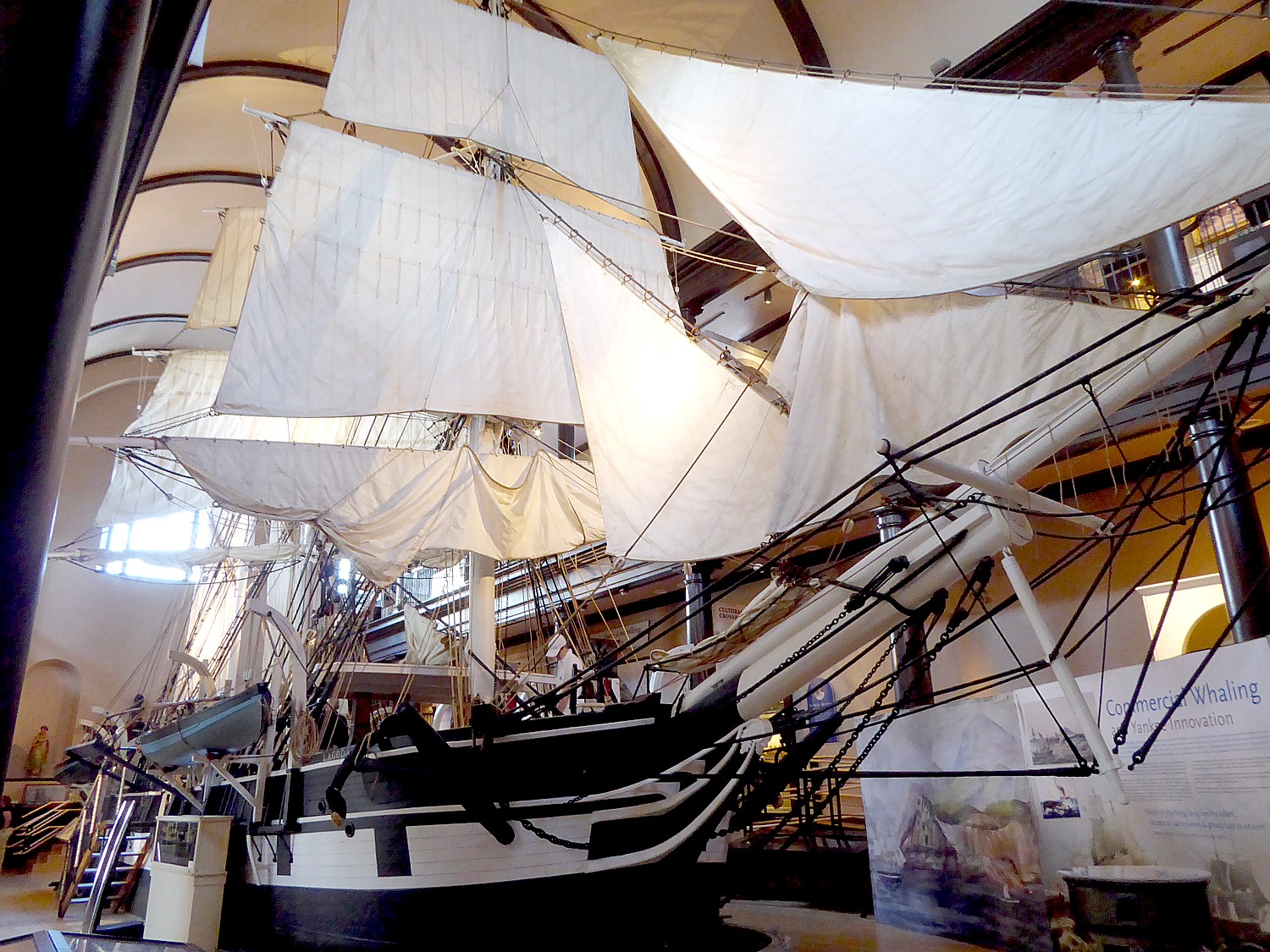
The stage set is based on drawings and prints from the period and is installed off the Lagoda’s bow so visitors can experience the performance from the deck, from theater seating on the floor level, or from vantage points to the port and starboard of the iconic whaleship.
Since the original score and narrative have been lost over time, they have been recreated and remastered for the new installation, and includes new research and points of interest.
Visitors are able to dive deeper into the specifics of the Panorama story on a large, touch-screen, interactive kiosk. The kiosk will have thematic tabs on various subjects, including a map of the voyage, related Museum artifacts and paintings, and the Panorama’s conservation history. You will be able to zoom in close to any scene or detail that interests you and get rich context for each section.
Enhancing the experience, artifacts from the Museum’s permanent collections further illustrate Russell’s own global travels and connect locations represented in the Panorama with relevant ethnographic material and objects. Exhibitions that tell the stories of Yankee Whaling, the connections with the Azores and Cabo Verde, as well as the many stories told in the existing Whaling Voyage ‘Round the World exhibition help amplify the content of the Panorama. The Panorama in the context of its own time – the era of the “public spectacle” is explored in the exhibition, and includes complementing pieces from the Museum’s permanent Collection.
While I strongly recommend the incomparable experience of seeing the mural first-hand and this Virtual Reality experience, the museum will also have an online digital version, an interactive designed to expand access to the Panorama and to supplement both the Spectacle in Motion exhibitions, the Original at the Kilburn Mill and The Experience at the New Bedford Whaling Museum. While it will work on a phone or tablet it has been optimized for desktop viewing.

The quality of the collection at New Bedford Whaling Museum – consisting of the merger of two private collections of whaling artifacts – is not to be believed, including what is claimed to be the largest collection of scrimshaw. I love the way the gallery rooms are like a warren – you come upon them.
I love the theming of the rooms: From Pursuit to Preservation: The History of Human Interaction with Whales; Energy and Enterprise: Industry an d the City of New Bedford; Enlightened Counters: the Two Nations of Manjiro Nakahama (about a 16-year old Japanese sailor who was rescued and spent eight years in New Bedford, the first Japanese person to live here, then went back to become a major counselor to the Emperor negotiating with the US and England) and The East Unlocks its Gates: American Whalers and Trade in Asia.
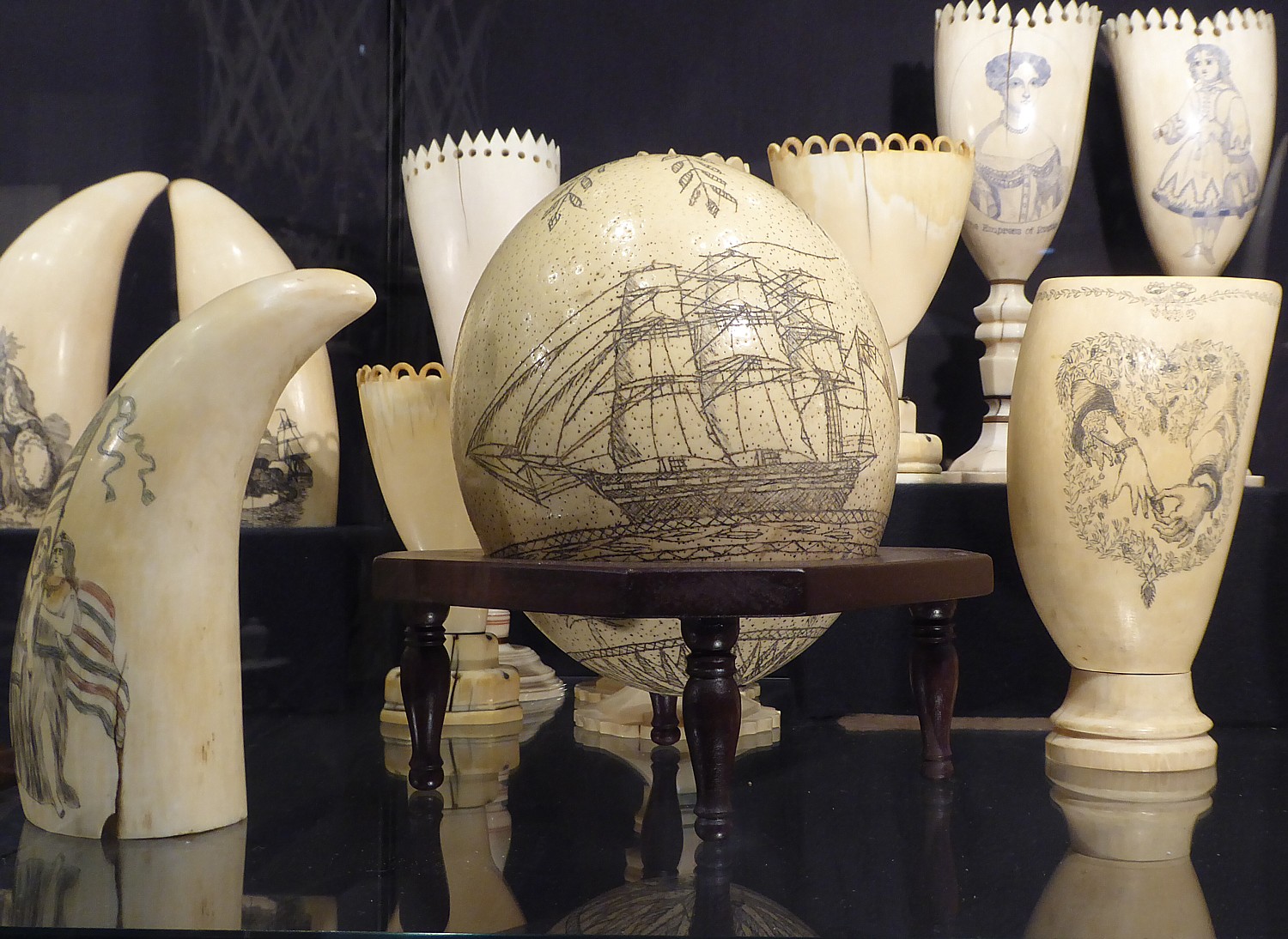
There is (of course) a Herman Melville room (while Melville never actually visited Nantucket before writing “Moby Dick,” he sailed from New Bedford on his whaling voyage), artifacts collected from around the world brought back by the whalers and opened the New Bedford people to the cultures of the world. There are sections dedicated to the Portuguese from the Azores and the sailors recruited from Costa Verde and how they impacted the diverse community in New Bedford. I am introduced for the first time to Captain Joshua Slocum, the first to solo circumnavigate the world.
An astonishing sight is the skeleton of a whale that is suspended from the ceiling as you enter the Museum, its bones with oily brown patches. It turns out that the bones still have oil which drips out and is collected in a jar below.
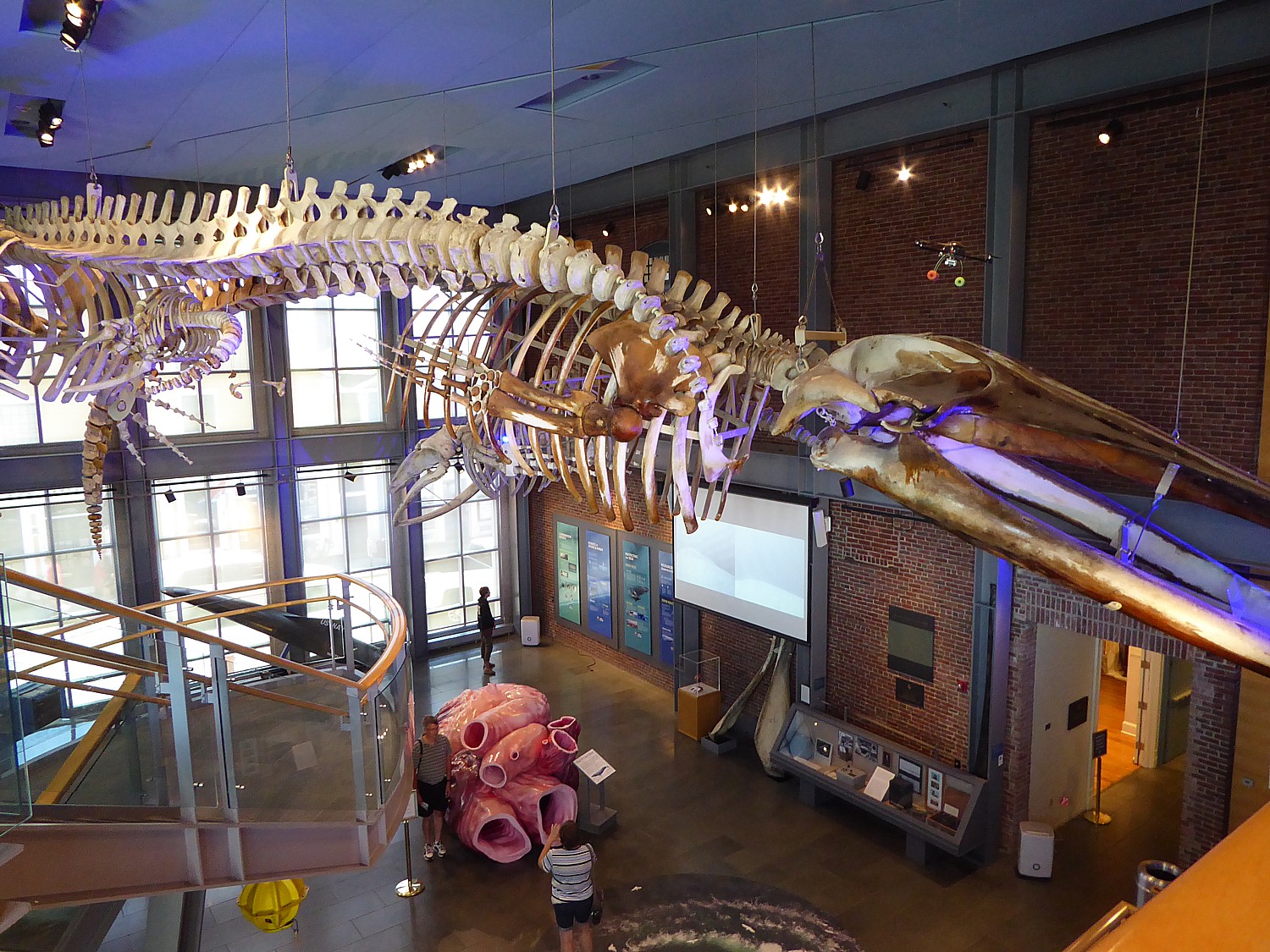
There is the world’s largest model whaleship, the Lagoda, at half-scale that takes up the entirety of the Bourne building, that you can climb aboard. In addition, there is the Mariner’s Home that is used for exhibit, and the Seaman’s Bethel which offers a superb video about whaling.
It drives home the theme that is so pressing today: “Trade: Expand American Ideas” (but also bring ideas back).
New Bedford Whaling Museum, 16 Johnny Cake Hill, New Bedford MA 02740, 508-997-0046, www.whalingmuseum.org.
They are contained within the New Bedford Whaling National Historical Park, a 13-block historic district of cobblestone streets, historic, stately buildings now juxtaposed with contemporary art galleries and funky restaurants and shops (my favorite: Sanctum – Folklorica: Apothecary and Witchwares, Tarot Reading). At the visitors Center, you can watch a 20-minute orientation movie and take in exhibits about whaling and New Bedford, “The City That Lit the World.” (www.nps.gov/nebe/planyourvisit).
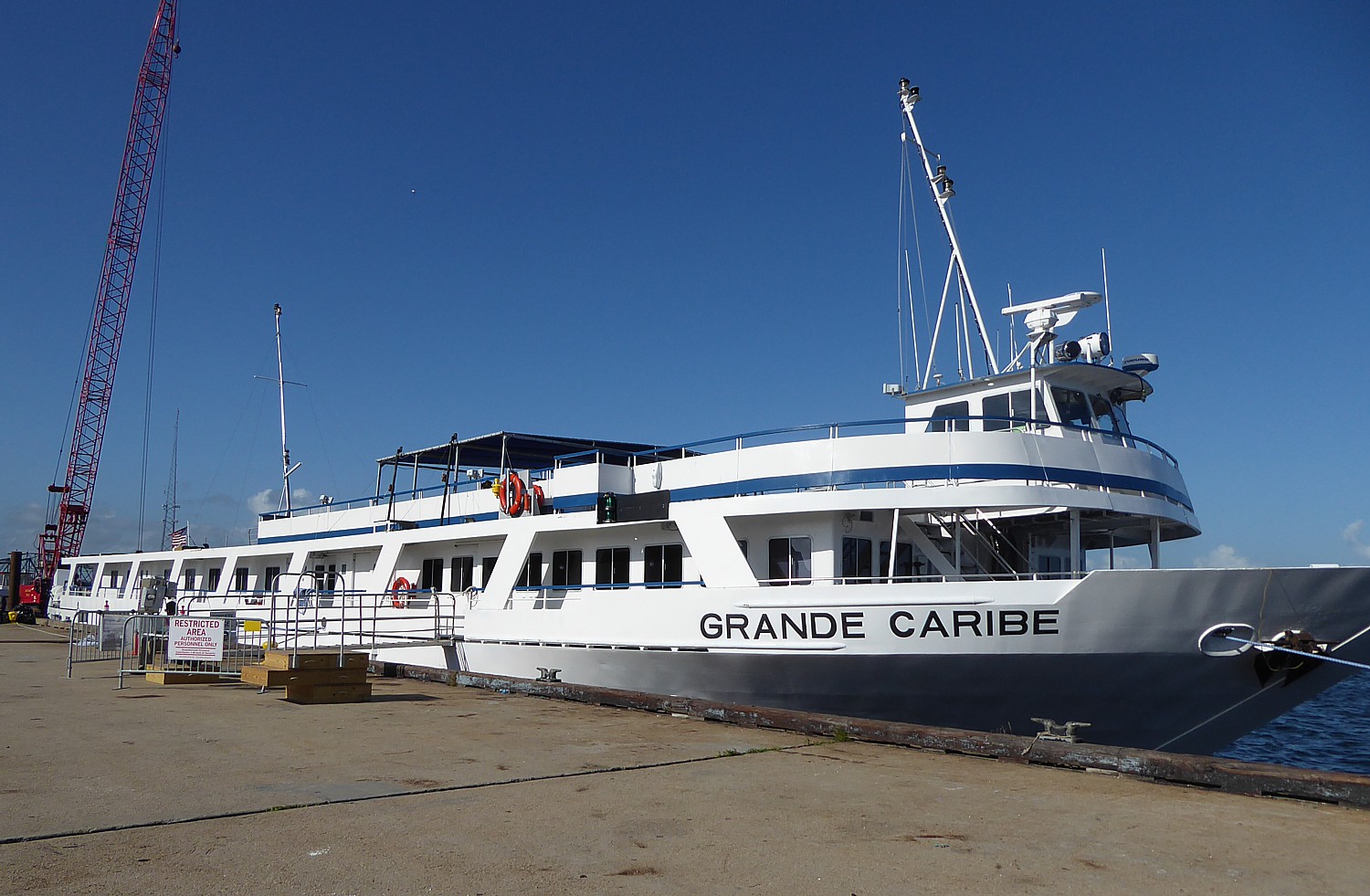
This was one of the incredible highlights of our own voyage aboard Blount Small Ship Adventures’ Grande Caribe, on the third day of a seven-day New England Islands cruise. We docked in the port along with the largest fishing fleet on the East Coast, and could look through etched glass of the same port in 1914 of our ship. Arriving by ship – we had come from Warren, Rhode Island to Bristol and had come this morning from Newport and will be going on to Martha’s Vineyard and Nantucket – made this experience even more tangible.
Blount Small Ship Adventures, 461 Water Street Warren, RI 02885, 800-556-7450, www.blountsmallshipadventures.com.
_____________________________
© 2018 Travel Features Syndicate, a division of Workstyles, Inc. All rights reserved. Visit goingplacesfarandnear.com, www.huffingtonpost.com/author/karen-rubin , and travelwritersmagazine.com/TravelFeaturesSyndicate/. Blogging at goingplacesnearandfar.wordpress.com and moralcompasstravel.info. Send comments or questions to FamTravLtr@aol.com. Tweet @TravelFeatures. ‘Like’ us at facebook.com/NewsPhotoFeatures
